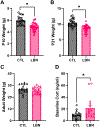Limited Bedding and Nesting as a Model for Early-Life Adversity in Mice
- PMID: 39072639
- PMCID: PMC12342394
- DOI: 10.3791/66879
Limited Bedding and Nesting as a Model for Early-Life Adversity in Mice
Abstract
Early-life adversity (ELA), such as abuse, neglect, lack of resources, and an unpredictable home environment, is a known risk factor for developing neuropsychiatric disorders such as depression. Animal models for ELA have been used to study the impact of chronic stress on brain development, and typically rely on manipulating the quality and/or quantity of maternal care, as this is the major source of early-life experiences in mammals, including humans. Here, a detailed protocol for employing the Limited Bedding and Nesting (LBN) model in mice is provided. This model mimics a low-resource environment, which provokes fragmented and unpredictable patterns of maternal care during a critical developmental window (postnatal days 2-9) by limiting the amount of nesting materials given to the dam to build a nest for her pups and separating the mice from the bedding via a mesh platform in the cage. Representative data are provided to illustrate the changes in maternal behavior, as well as the diminished pup weights and long-term changes in basal corticosterone levels, that result from the LBN model. As adults, offspring reared in the LBN environment have been shown to exhibit an aberrant stress response, cognitive deficits, and anhedonia-like behavior. Therefore, this model is an important tool to define how the maturation of stress-sensitive brain circuits is altered by ELA and results in long-term behavioral changes that confer vulnerability to mental disorders.
Conflict of interest statement
DISCLOSURES:
The authors have no conflicts of interest.
Figures



References
-
- Warhaftig G, Almeida D, Turecki G Early life adversity across different cell- types in the brain. Neurosci Biobehav Rev. 148 105113 (2023). - PubMed
Publication types
MeSH terms
Grants and funding
LinkOut - more resources
Full Text Sources
Research Materials
